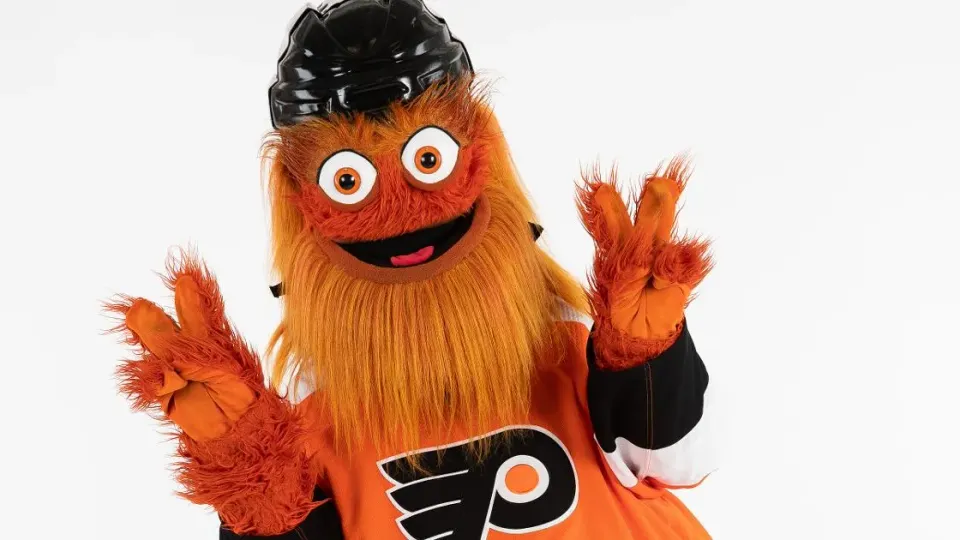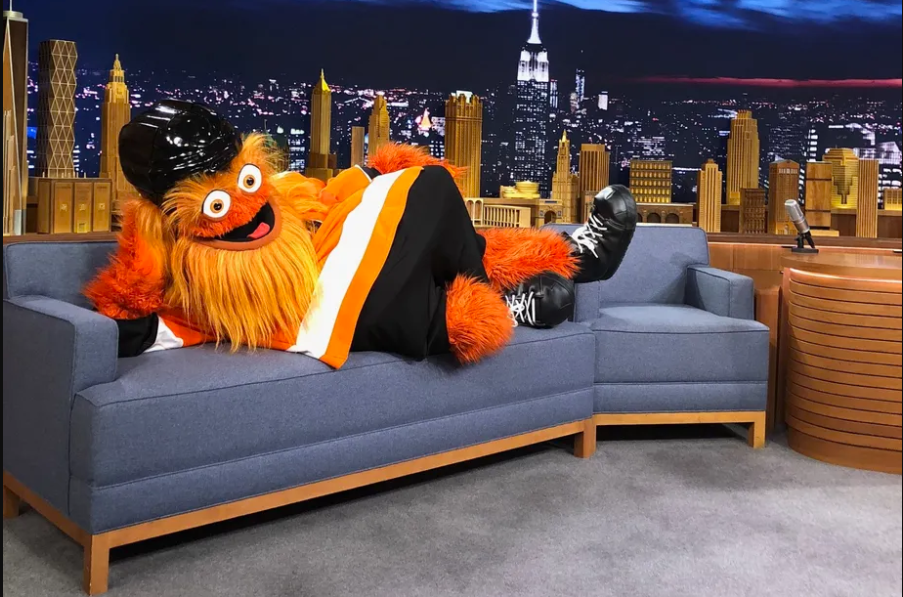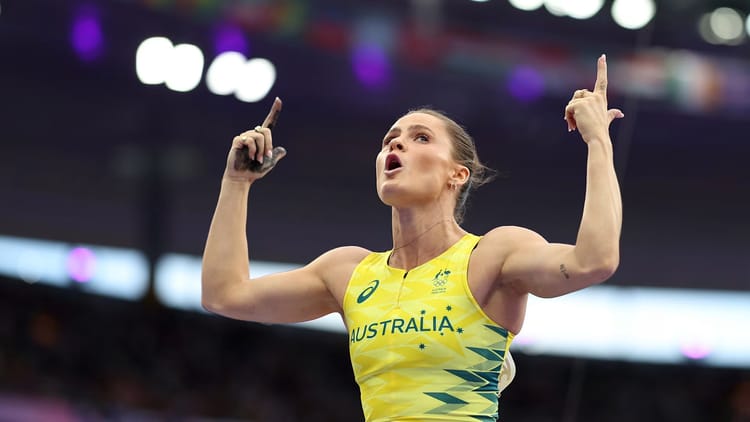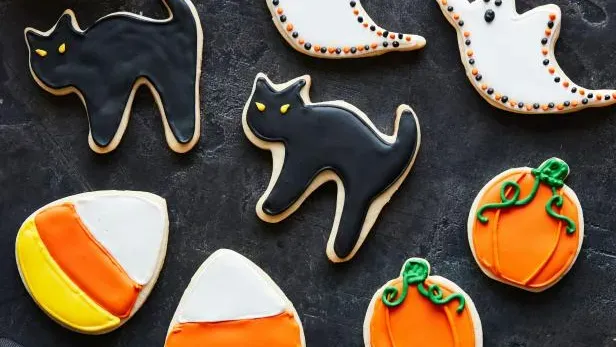Why Gritty has so many non-binary and genderfluid fans

(Welcome to the Wednesday newsletter! Each week, I’m publishing a new pop culture essay from a freelancer. Remember: Your subscription fee helps me pay these freelancers for their efforts! This week: Jessica Gentile on the gender fluidity of a mascot near and dear to my heart: Gritty.)
When Acacia O’Connor decorated their home for the holidays last year, they eschewed the typical red and green adornments for their Christmas tree. For this journalist, only one theme would do: Gritty, the glorious, googly-eyed, furry agent of chaos, a cultural phenomena who almost incidentally serves as the fulltime mascot of the Philadelphia Flyers. It might seem odd that someone would dedicate their holiday décor to a mascot-turned-meme, but to O’Connor, who is non-binary, Gritty is more than that. He stands outside of simple binaries, especially when it comes to gender.
With his orange fur, squeaky hands, savvy social media presence, and seemingly boundless supply of chaotic energy, it’s easy to see why Gritty has captured the attention of the internet and the world since his emergence in 2018. Gritty has been embraced on a local and global level — from hometown hockey fans who identify with his scrappy spirit to the political left who see him as a symbol of anarchic goodness. But in all of the media attention foisted on Gritty and those who love him, the specific fondness for Gritty among many who are trans, non-binary, or genderqueer has gone virtually uncovered.
At first glance, it might seem antithetical that a burly, bearded creature that represents (and was created within) the hypermasculine realm of the NHL might appeal to those who are gender non-conforming in some way or another. But upon closer inspection, this perspective completely checks out.
Let’s start with Gritty’s physical appearance. Gritty’s athletic façade — the classic helmet hockey jersey, gym shorts and skates — only represents one facet of his personality and even his gender expression.

Gritty boasts a wide range of looks. He has interchangeable belly buttons, of every color imaginable, as well as a belly button ring that he showed off while dancing to Lizzo. He frequently sports a green tutu (and nothing else), and he even dressed up as Wonder Woman for Halloween. Gritty is totally chill using “he” pronouns as he is unironically using the hashtag HotGirlSummer. He once tweeted “Skirts are mad comfy” with such menace and conviction in his googly eyes that you wouldn’t dare deny that gender is a social construct. None of this is played for laughs either. His gender fluidity is as much a part of his being as his love for hockey.
From a purely visual standpoint, Gritty is the sort of spectacle we rarely see in professional sports. The flamboyance of his style and personality create a theatrical experience beyond the high stakes drama inherent to athletic competition. To fans like O’Connor this means a lot “Gritty really represented the fullness of me,” they said. “The extravagance of him — all fur, eyes akimbo, turquoise belly button. Gritty is as other, as alien and as spectacular as can be imagined.”
O’Connor isn’t the only one who’s claimed Gritty as a non-binary hero. With over 23,000 members, Gritty Memes for Philly Teens is one of the biggest Gritty fan communities on Facebook. You can spend hours scrolling through posts that dissect and debate Gritty’s interests, politics, and yes, gender. Most members act under the belief that Gritty is an autonomous creature divorced from corporate interests and even divorced from hockey. A post in which Gritty reveals a rainbow belly button is captioned “GRITTY REJECTS GENDER BINARIES.” (The post got nearly 700 reactions, nearly all positive.) You can purchase fan-created t-shirts on Etsy that boldly declare, “Gritty is non-binary. Get over it.”
The “Gritty as non-binary” narrative has even been embraced beyond the internet. In 2018, Philadelphia Council Member Helen Gym released an official resolution welcoming Gritty to the city. The resolution recognizes Gritty as “a non-binary leftist icon, an orange menace, a raging id, and an antihero. He has been characterized as huggable but also potentially insurrectionary, ridiculous, horrifying, unsettling, and absurd.”
Gym’s description embodies the full range of public reactions Gritty has garnered. He’s at once embraceable, unsettling, and threatening on and off the ice. That full range of reactions is no doubt spurred on by his continual gender play. After all, one minute he’s flaunting a fur coat and sipping sparkling cider in a limo, while the next minute he’s doing interpretive dance in a ballet tutu. Then he streaks naked across the arena and throws cakes in people’s faces, all within the span of days.
It’s hard to think of spaces (especially in professional sports!) where these sorts of contradictions — masculine aggression meets high femme theatrics — are not only acceptable, but celebrated. And that too is what drew O’Connor and so many others to Gritty. As O’Connor notes, “His increasingly chaotic energy and social media savvy made it feel like it’s just a relief to be surprised. That’s queerness too, surprise and delight.”
But just how intentional is Gritty’s gender fluidity, and who exactly gets to decide how a fictional character identifies? As one post on the aforementioned Facebook page cryptically states “Gritty’s gender is ‘gender with a hard g like in Gritty” While meant as a joke, the dozens of comments that ensue take that question surprisingly seriously.
While a professional sports team on the national level would likely never create a mascot meant to disrupt the traditional gender paradigm, the Flyers nonetheless gave some thought to that very question. According to a South Jersey Magazine interview with Joe Heller, the Flyer’s vice-president of marketing, Gritty’s gender “was really never designated. We refer to a ‘creature’ or a ‘monster.’ So at the end of the day, that’s basically the reference. I don’t think we’ve ever said what he is other than – he’s obviously not a human.”
It’s telling that the organization views someone who doesn’t adhere to the male or female binary as a monster. The thought that someone lacks personhood if they don’t fall within the typical binary is dehumanizing to be sure and sadly not uncommon. It’s also disappointing, but necessary to note that Gritty took part in a pregnant couple’s “gender reveal” much to the chagrin of his leftist fans. And it’s not like any trans players are likely to be seen on the ice anytime soon (at least skating under their gender — a few trans hockey players have transitioned after leaving the game), given the notorious and systemic levels of discrimination trans and non-binary athletes face.
But maybe the battle over Gritty’s gender represents a chance to flip the switch. The ability for trans and enby fans to co-opt monstrosity ends up being a means to normalize and celebrate existing outside traditional societal boxes, even in something as superficial as a mascot.
That’s how O’Connor sees it at least. “There’s this freedom represented by Gritty, by facing the meaninglessness of a sports mascot head on but somehow then, through that, creating actual meaning.” It’s a meaning that’s sorely needed and thoroughly lacking in most of pop culture. Gritty embodies gender elements that society continually pits against each other, only to smash them to bits as if to say gender is chaos itself.
Episodes is published three times per week. Mondays feature my thoughts on assorted topics. Wednesdays offer pop culture thoughts from freelance writers. Fridays are TV recaps written by myself. The Wednesday and Friday editions are only available to subscribers. Suggest topics for future installments via email or on Twitter. Read more of my work at Vox.





Member discussion